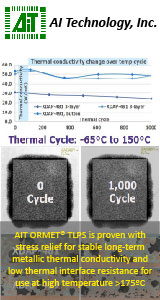|

|
|
| Ask the Experts | |||||||
|
|||||||
|
May 25, 2018 - Updated November 8, 2010 - Originally Posted Solder Bridging Problem on Header ConnectorWe have been struggling to eliminate solder bridging during wave soldering on a 10 x 2 row through hole header connector. We see bridging on most every connector but not on other types of components. Do you have any suggestions? F. O. |
|||||||
| Expert Panel Responses | |||||||
|
First you will need to determine if this is a design related bridging issue or a process related defect. For design related defects consider the following. This can include, but is not limited too:
Eastern Manager Vitronics Soltec John Norton started his soldering career in 1983 for Hollis Engineering. He has also worked with Electrovert as a technical training manager and Vitronics Soltec for the last ten years. He has held various technical development and sales positions.
Try to rotate the direction of the pcb flow by 90 deg, ie, have the connector parallel to the conveyor flow, if possible. If not, try soldering at different conveyor speeds.
Managing Director, Asia Pacific ECD EH Lim has been in the PCB Assy industry since 1985, starting at Thomson/Singapore for 5 years before moving to Electrovert Asia Pacifc. Lim was Sales Director for Vitronics Soltec prior to joining ECD in 2007 as Managing Director for Asia Pacific.
Have you considered selective soldering? You have a lot more control over the process and it's easier to eliminate bridging.
National Sales and Marketing Manager, North America Business Development Manager, DAGE | X-Ray component counting Mr. O'Neil has been in the electronics manufacturing industry for over 20 years.
Reader Comment
You can put the silk screen in between the PTH. So, as solder resist, it can prevent the bridging formed. Secondly, the pin over the board should be from 0.8 to 1 mm.
Boris, China
A pictorial of your issues would have helped us to response more accurately. Anyway, below are few actions & hope you find a solution out of it.
PCBA Industrialization Schneider Electric Experienced engineering leader with 25+ years in electrical & electronic components qualification, reliability testing, and global lab operations. Expertise includes batteries, transformers, cables, connectors, PCB/PCBA processes, and active & passive electronic components, along with supplier capability development. Recognized for driving innovation, standardization, and technical excellence across global teams.
|
|||||||
| Submit A Comment | |||||||
|
Comments are reviewed prior to posting. You must include your full name to have your comments posted. We will not post your email address. |
|
Free Newsletter Subscription
Circuitnet is built for professionals who bear the responsibility of looking ahead, imagining the future, and preparing for it. Insert Your Email Address |
|

|





